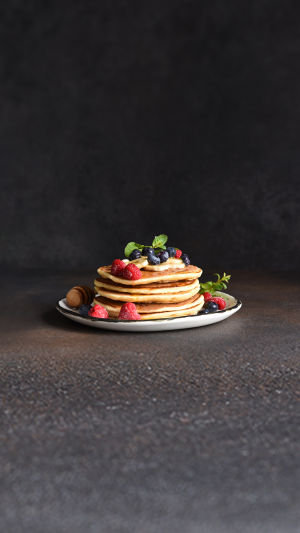Who doesn’t love pancakes? They’re a breakfast staple that brings comfort and joy.But if you’re looking for a healthier version, you don’t have to sacrifice taste.
Here’s how to make pancakes that are not only delicious but also packed with nutrition.
<h3>Start with Whole Grains</h3>
One of the easiest ways to boost the health factor of your pancakes is by switching out refined flour for whole grains. Whole wheat flour, oat flour, or even buckwheat flour are excellent choices. Whole grains are rich in fiber, which helps keep you full and supports healthy digestion. They also provide more nutrients like iron, magnesium, and B vitamins.
You can try blending rolled oats into flour at home for a hearty texture, or mixing a few different whole grain flours to add complexity to the flavor. The result is a more wholesome and nutty pancake that still has a soft, fluffy texture.
<h3> Swap Sugar for Natural Sweeteners</h3>
Traditional pancake recipes often call for a significant amount of sugar, but you don’t need that for great-tasting pancakes. Instead, use natural sweeteners like mashed bananas, applesauce, or a little honey or maple syrup. These add sweetness without the need for refined sugars and also provide vitamins, fiber, and antioxidants.
For example, a mashed banana can add moisture and sweetness while cutting back on added sugar. If you prefer syrup, go for pure maple syrup and drizzle it sparingly over your pancakes after they’re cooked.
<h3>Add Protein for Balance</h3>
To keep your pancakes filling and nutritious, it’s important to balance out the carbs with some protein. Adding Greek yogurt, cottage cheese, or protein powder to your batter is a great way to boost the protein content. This helps balance your meal and prevents a mid-morning energy crash.
Eggs are also a classic ingredient in pancakes and add both protein and a fluffy texture. If you’re looking for a plant-based alternative, you can use chia seeds or flaxseeds mixed with water to create a similar binding effect, with the added bonus of omega-3s.
<h3>Incorporate Healthy Fats</h3>
Instead of butter, opt for healthier fat options like coconut oil, avocado oil, or even nut butter. These fats are not only better for heart health but also give the pancakes a subtle richness. You can add a tablespoon or two of almond or peanut butter into your batter for a protein boost and nutty flavor.
Another great option is to top your pancakes with slices of avocado, a spoonful of Greek yogurt, or a handful of nuts. These healthy fats will keep you satisfied and energized throughout the day.
<h3>Don’t Forget the Add-Ins</h3>
The beauty of pancakes is that you can customize them endlessly. Adding fruits like blueberries, strawberries, or grated apple gives the pancakes a natural sweetness and a boost of antioxidants. You can also mix in some chopped nuts or seeds, like almonds or chia seeds, for extra crunch and nutrition.
For a more indulgent twist, try adding dark chocolate chips (in moderation). Dark chocolate is rich in antioxidants and can give your pancakes a deliciously decadent touch while still being on the healthier side.
Apple Pancakes Recipe with Yogurt and Oats - No Sugar No Oil No Flour
Video by My Favorite F Word
<h3>Cooking Techniques Matter</h3>
The way you cook your pancakes can also influence how healthy they are. Instead of frying your pancakes in loads of butter or oil, lightly grease your pan with a small amount of oil or use a non-stick skillet. Cook them on medium heat, which allows them to rise properly without burning, and ensures that they’re evenly cooked.
If you want to cut down on oil even further, try baking your pancake batter in muffin tins to create “pancake muffins.” This method uses very little oil and makes for a convenient, on-the-go breakfast.
<h3>Top It Right</h3>
While traditional pancake toppings like butter and syrup are delicious, they’re also high in sugar and fat. For a healthier twist, top your pancakes with Greek yogurt, fresh fruit, a sprinkle of nuts, or even a drizzle of almond butter. These toppings are not only nutritious but also add texture and flavor to your pancakes.
A little bit of pure maple syrup is fine if you prefer the classic route, but try to be mindful of portion sizes. A tablespoon or two is enough to enhance the flavor without overwhelming the health benefits you’ve built into your pancakes.
<h3>The Benefits of Eating Pancakes</h3>
When made with wholesome ingredients, pancakes can be a healthy breakfast option. Whole grains provide sustained energy, protein helps keep you full, and the addition of fruits and healthy fats offers essential nutrients and antioxidants. Best of all, making healthier pancakes doesn’t mean losing out on flavor. You’ll still get that comforting, warm stack you love, but with more goodness packed into every bite.





